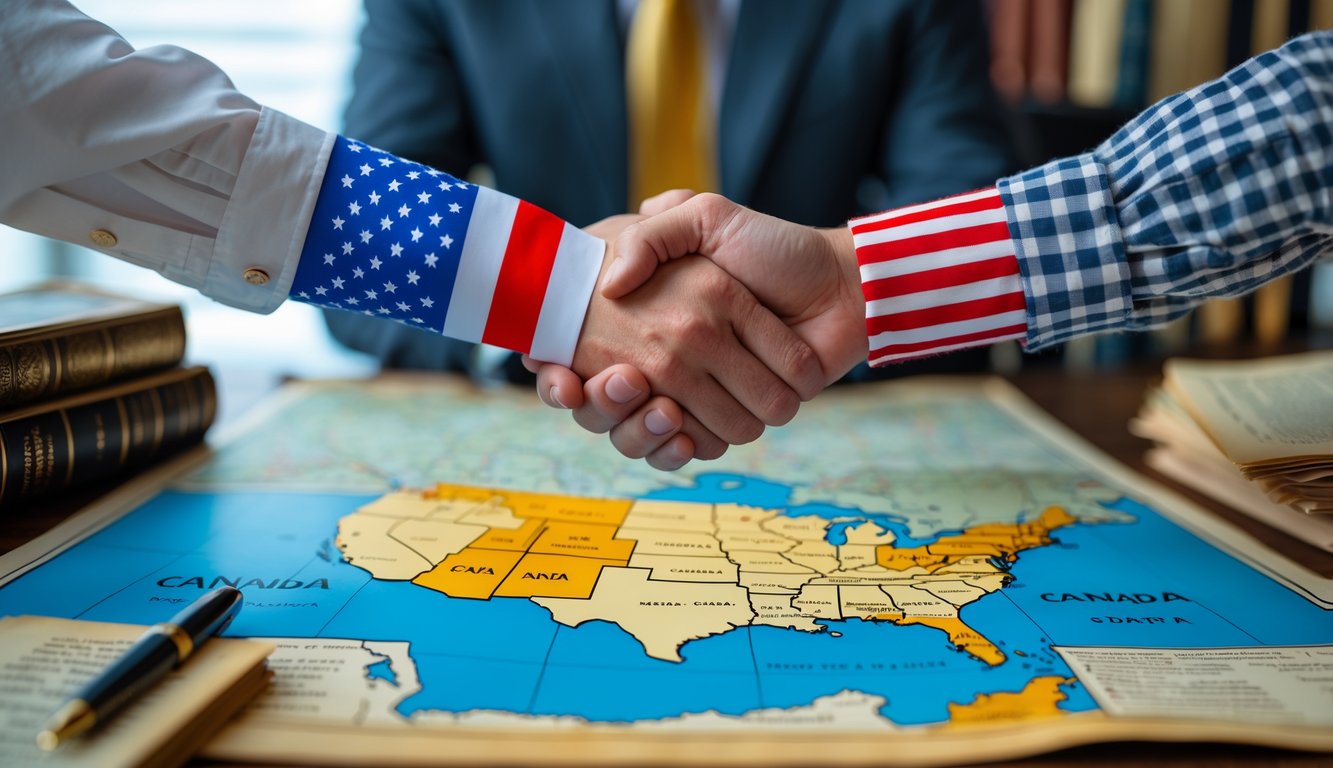The Case for Canada Becoming the 51st State of America: Weighing Economic and Political Impacts
If you’ve ever wondered what it might mean for Canada to become the 51st state of the United States, you’re not alone. The topic has sparked both serious debate and playful conversation for years. Some believe that annexation could offer economic benefits and security, while others argue it would mean giving up an important national identity.
There’s a long history of ideas and proposals around this topic. At different times, public figures have discussed whether joining the United States would bring more opportunities or challenges for people living in Canada. Discussions around the 51st state even drew recent attention in public debates and news stories, showing that this is not just an old idea but a question some still consider relevant today.
Understanding the reasons some people support or oppose the idea can help you form your own opinion. By exploring arguments from both sides and considering how annexation could impact daily life, this article helps you get a clearer picture of the potential future between Canada and the United States. To learn more about the history and process, you can check this detailed explanation about how the process works.
Historical and Political Background

Understanding the political relationship between Canada and the United States involves exploring key events, legislative mechanisms, and past statehood admissions. Important historical moments and constitutional processes shape the debate around annexing Canada.
Origins of Annexation Discussions
Talks about Canada joining the United States trace back to the 18th and 19th centuries. Early ideas came up after the American Revolution, when some U.S. leaders hoped that Canadian provinces would align with their new country. For years, there were scattered debates, but Canada’s formation as a country in 1867 ended most serious proposals.
During the 20th century, suggestions for annexation surfaced at times, but they were never widely accepted in either country. A recent article highlights that Canadian identity grew stronger after gaining full constitutional independence in 1982. Today, opinion polls and surveys regularly show most Canadians reject the idea of joining the U.S.
Past Precedents: Alaska, Hawaii, and Puerto Rico
The United States has admitted new states before. Alaska and Hawaii are the most famous examples, joining in 1959. Their paths involved local support, a referendum, and U.S. congressional approval. For example:
| State | Referendum Held | Congressional Approval | Year Admitted |
|---|---|---|---|
| Alaska | Yes | Yes | 1959 |
| Hawaii | Yes | Yes | 1959 |
| Puerto Rico | Yes (Several) | No | Not Admitted |
Puerto Rico has voted more than once for statehood, but the U.S. Congress has not approved its admission. Comparing these cases, the process is lengthy and requires both public and political agreement.
Role of the U.S. Constitution and Admissions Clause
The U.S. Constitution, through the Admissions Clause (Article IV, Section 3), sets the legal process for adding new states. This clause allows Congress to admit new states by law, but it does not describe specific steps for special cases like annexing Canada.
For a foreign country to become a state, a treaty or agreement would likely be needed first. Any change would also need to respect both the U.S. Constitution and the Canadian constitution. Major amendments and changes would be required on both sides, making the legal hurdle very high.
Statehood Referendum and Congress Approval
Statehood requires support from both the population seeking to join and the U.S. federal government. A binding, fair referendum is usually the first step. For Alaska and Hawaii, a simple majority was enough to move the process forward.
After a successful referendum, the U.S. Congress must then pass an act of admission. Both the House of Representatives and the Senate need to agree. In the case of Canada, this would involve complicated negotiations between the two countries, as well as changes in the U.S. Congress and Canadian law. Without broad and deep support on both sides, statehood would not be possible.
Economic and Social Impacts

Joining the United States would reshape Canada’s economy and social programs in many areas. Your daily life could change in areas like healthcare, trade, innovation, and public services.
Trade Relations and Tariffs
You would see immediate changes to trade barriers. Tariffs and customs checks between Canada and the U.S. would likely disappear, making it easier and cheaper for goods and services to move across the border.
This is important because more than 20% of Canada’s gross domestic product relies on exports to the United States. Lowering these barriers would help Canadian businesses reach a much larger market. At the same time, U.S. products and services would likely become more available and possibly less expensive.
A closer trade relationship might bring new jobs and increase competition. However, industries that rely on current protections may need to adapt to new rules.
Universal Healthcare and Social Welfare
You would face big changes in your access to health care. Canada’s universal healthcare system is different from the American approach, which is mostly private and requires personal payments or insurance.
Becoming a U.S. state could mean a shift from government-funded healthcare to market-based insurance and programs such as Medicaid and Medicare. You may see increased choice in providers, but also new costs for care and prescriptions.
Social welfare programs like unemployment benefits and child support would follow U.S. standards. Some groups may gain broader support, but others could find programs less generous or harder to access.
Economic Growth and Innovation
The combined market would create new economic opportunities for you and your community. As the largest economy in the world, the economic output of the U.S. would get a big boost by adding Canada’s talent and resources.
Innovation might rise as Canadians plug into larger pools of investment, research, and job networks. Access to advanced technology and finance could improve, helping entrepreneurs and workers compete more easily with global peers.
Despite new opportunities, the economic landscape could become more competitive. You might see greater rewards for skills and productivity, but there is also more risk if you cannot keep up with changes.
Infrastructure and Safety Net Changes
Roads, bridges, public transit, and other infrastructure would likely be managed and funded under U.S. rules and budgets. You might see new projects or upgrades, but priorities could shift from current Canadian practices.
The social safety net—including food assistance, temporary relief, and disability support—would fall under U.S. systems, which tend to focus on state-based management and a mix of federal and state funding.
You could experience faster access to some services. However, programs might be less universal, and people in need may face tighter eligibility rules or shorter-term help. The structure of these safety nets would depend on new state and federal laws as well as available funding.
Governance and Political Integration

Becoming the 51st state would change how you are governed, reshape how laws are made, and transform how your voice is heard in Washington, D.C. Provinces and territories would face important changes in political status and local control.
Merging Federal Governments and Laws
Canada’s current federal government and the Canadian constitution would be replaced by the system used by the United States. This includes adopting the U.S. Constitution, merging Supreme Courts, and following American federal and state laws.
Civil rights protections, Congress’s lawmaking power, and the role of federal courts would all operate under U.S. rules. Important Canadian programs like public healthcare would become subject to U.S. policy, which could lead to significant changes. Any special Canadian laws would need to align with U.S. constitutional rights.
You would also see new agencies taking over certain responsibilities. This would affect everything from banking regulations to criminal law. The process of merging legal systems would require careful negotiation, as not all Canadian laws have a direct American equivalent. See more about these differences at Iona Journal’s analysis.
Representation in the Electoral College and Congress
Statehood would give you representation in both the U.S. House of Representatives and the Senate. Based on population, Canada could gain about 30-40 members in the House, giving you a significant share of the total 435 seats. You would also get two new U.S. Senators, just like every other state.
You would become voters in presidential elections through the Electoral College. Canada’s population could mean around 40-50 electoral votes, making your voice important in close elections.
This new representation could shift the balance of power in Congress. With your members, votes on issues like house majority or senate filibuster could become much more competitive. Find more details on these shifts at The Hill’s analysis.
Effects on Provinces and Territories
Canadian provinces and territories would need to transition into what are called U.S. states or possibly territories, depending on how Congress chooses to organize them. Each province could become its own state, or some regions could be combined.
Local parliaments would be replaced by state legislatures. The process would create opportunities for provinces to manage their own education, health, and social policies within U.S. state guidelines. However, powers not given to states would fall to the federal government.
Territories that are not full provinces may face different treatment. Some might become full states, while others could have a status similar to current U.S. territories. For more depth on these changes, see Global News’ detailed process explanation.
Cultural Identity and Public Opinion

When you look at the idea of Canada joining the United States, there are important questions about identity, history, and how people on both sides of the border feel about such a merger. Attitudes from Canadian leaders and recent political events also shape how this debate unfolds.
Canadian National Pride and Cultural Identity
Canadian cultural identity is shaped by values like universal healthcare, multiculturalism, and a strong sense of national pride. Most Canadians see these as defining features that set them apart from Americans. Surveys show that over 88% of Canadians feel a strong link to these values, and less than 7% support any type of merger with the United States.
This pride is driven by a distinct history and a desire to preserve things that make Canada unique. There is real concern among Canadians that joining the U.S. would overshadow their traditions and history. Even the idea of becoming the 51st state tends to increase national pride, leading to more public displays of what it means to be Canadian. You can get a deeper look at this in recent analysis on Canadian identity.
Relationship Between Canadians and Americans
The populations of both countries share a long border and often have close personal ties through travel, trade, and family connections. But there remain differences in values, healthcare systems, and national symbols. Many Canadians see their relationship with Americans as friendly, but they also want to keep their independence.
When public opinion is measured, most Canadians do not support joining the U.S. as a state. Even in Alberta, where some citizens petitioned for statehood, the idea faces strong resistance and has sparked a bigger debate about identity and values. The ongoing discussion in Alberta shows how complex and emotional this issue can be for you and your neighbors, as described in a recent coverage of Alberta’s petition.
Political Leadership: Justin Trudeau, Doug Ford, Donald Trump
Political leaders have a major influence on the 51st state debate. Donald Trump has talked about the idea of Canada joining the U.S., which caused a wave of national pride and strong responses from Canadian officials. When asked, Justin Trudeau made it clear there is “no chance” of Canada becoming a U.S. state, strengthening public opposition.
Doug Ford, as a political leader in Canada, usually supports maintaining Canadian autonomy, focusing on local priorities. Trump’s “Make America Great Again” message sometimes creates more distance, reminding Canadians of what they want to protect. These statements reinforce the strong belief that Canada’s population wishes to remain separate, despite being neighbors. You can read more about how recent statements by political figures have impacted public opinion and national pride in this article about leadership and identity.
Frequently Asked Questions

When discussing Canada potentially becoming the 51st state, key issues include economic changes, political impacts, legal questions, healthcare shifts, cultural concerns, and lessons from history. Understanding these details gives you a clear view of the real challenges and possible gains.
What are the potential economic benefits for both Canada and the United States if Canada were to become the 51st state?
Trade between Canada and the United States already tops $700 billion each year. Removing the border could make it easier for businesses to grow and move goods without paying tariffs or facing complex regulations. Citizens might gain more job opportunities if resources, money, and workers move more freely.
Taxes and wages could shift to align more closely, which may help some people but pose problems for others. Some experts suggest combining the economies could grow wealth on both sides, but others warn of risks such as lost government revenues or differences in social programs. For further insights, see how the process works.
How would Canada’s incorporation as a state impact the political landscape of the United States?
Canada would add close to 40 million people, which means more seats in the House of Representatives and more votes in presidential elections. This could change the balance of power between political parties and even affect laws and Supreme Court decisions.
Bringing in new senators and representatives could shift key national debates and make policymaking more complex. Some Americans and Canadians would welcome these changes, while others might worry about losing influence or control.
What are the legal and constitutional challenges associated with a foreign country becoming a U.S. state?
The U.S. Constitution does not lay out steps for adding an entire country as a state. Admission would require approval by both the U.S. Congress and the people of Canada, likely through referendums and new treaties. Changes to laws in both countries would be needed, and some current agreements may no longer apply.
Lawyers and lawmakers would need to go through years of negotiations and debates before making such a major change. It is highly unlikely—experts say there is “no real chance” of this happening right now. You can read about what’s involved in the process.
How might Canada’s healthcare system be affected by integration into the United States?
Canada’s system provides universal health coverage funded by taxes. In contrast, the United States has a mix of public and private coverage, with many people relying on private insurance.
If Canada joined as a state, the current system could face pressure to change or even merge with American models. This might lead to higher healthcare costs for some Canadians and more private options, but it could reduce wait times for care.
What cultural and national identity issues might arise from Canada joining the United States?
Canada and the United States share some values, but many Canadians take pride in their unique culture, languages, and sports. Joining the United States might make some people feel they are losing their identity or traditions.
There could be debates about education, holidays, and official languages. Many Canadians and Americans feel a strong sense of patriotism that might clash if both countries become one.
What are the historical precedents for territories or countries becoming states within the United States?
In the past, U.S. territories such as Hawaii and Alaska became states after extended legal and political steps. These changes happened after local populations showed they wanted to join, and both Congress and the President approved. The process was complex but only involved territories, not fully independent countries.
No independent country as large as Canada has ever become a state within the United States. The historical process shows it would require massive political agreement and major legal changes. Learn more about some historical ideas and arguments.



